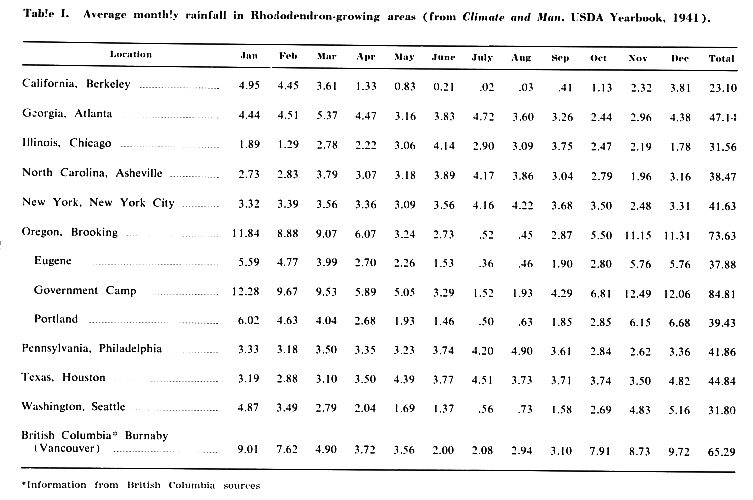QBARS - v22n2 Climates of Selected Rhododendron-Growing Areas
Climates of Selected Rhododendron-Growing Areas
R. L. Ticknor, Aurora, Oregon
* I wish to acknowledge help from Mr. Gilbert L. Sternes, State Climatologist, U.S. Weather Bureau, Portland, Oregon, in obtaining data for this report.
Many of our members will be coming to the 1968 American Rhododendron Society annual meeting in Eugene, Oregon, in May. It might be of interest to compare the climate of Eugene to that of other areas of the country in which Rhododendrons are grown. Information about the areas of the 1969 (Georgia) and 1970 (British Columbia) annual meetings is also included.

|
It is often stated that the Pacific Northwest climate, being cool and humid, is ideal for growing Rhododendrons. A look at the monthly rainfall distribution (Table I) will show that this is not necessarily true. In contrast to much of the eastern part of the country, our dry months-July and August-which normally have less than 1 inch of rainfall each, are our hottest months. During the cool fall and winter months, we have a surplus of water. Much of this precipitation occurs as snow in the mountains, providing the water for irrigation in the summer dry season.
Rhododendrons are not native in the Willamette River valley, of which Eugene and Portland are at opposite ends. Rhododendron macrophyllum occurs on the ocean side of the coastal mountains and on the western side of the Cascade Mountains. R. occidentale occurs on the southern Oregon coast and R. albiflorum in the Cascade Mountains. R. occidentale occurs on the southern Oregon coast and R. albiflorum in the Cascade Mountains. Both Brookings, on the southern Oregon coast, and Government Camp at 3900 feet on Mount Hood, have much greater rainfall and cooler July temperatures than Eugene or Portland.
| Table II. Temperature records in Rhododendron-growing areas from Climatography of the United States, 86. | ||||||||
|
Average
Temperature Extremes |
January
Average |
May
Average |
July
Average |
|||||
| Location | Max | Min | Max | Min | Max | Min | Max | Min |
| California, Berkeley | 106 | 25 | 55.3 | 42.2 | 66.0 | 49.9 | 69.5 | 53.7 |
| Georgia, Atlanta* | 103 | -8 | 53.6 | 35.7 | 81.5 | 60.0 | 89.1 | 70.3 |
| Illinois, Chicago | 109 | -20 | 33.1 | 20.4 | 66.3 | 51.0 | 81.5 | 68.1 |
| North Carolina, Asheville | 97 | -6 | 48.3 | 29.7 | 74.7 | 52.1 | 83.5 | 63.1 |
| New York, New York City | 102 | -14 | 39.5 | 25.6 | 68.8 | 61.5 | 82.2 | 67.1 |
| Oregon, Brookings | 100 | 17 | 53.1 | 41.2 | 62.2 | 46.3 | 65.1 | 50.9 |
| Eugene | 105 | -4 | 46.4 | 34.4 | 67.3 | 43.5 | 82.2 | 50.4 |
| Government Camp | 99 | -16 | 34.9 | 23.1 | 54.0 | 35.1 | 69.4 | 44.8 |
| Portland | 107 | -2 | 45.5 | 36.3 | 67.9 | 49.3 | 79.3 | 57.4 |
| Philadelphia | 106 | -11 | 42.2 | 27.4 | 73.1 | 52.8 | 86.9 | 67.4 |
| Texas, Houston | 108 | 5 | 62.3 | 44.9 | 84.3 | 66.8 | 92.3 | 74.5 |
| Washington, Seattle | 98 | 3 | 44.8 | 36.1 | 64.1 | 47.7 | 73.9 | 55.3 |
|
British Columbia, Burnaby,
(Vancouver) |
95 | -9 | 46.0 | 34.0 | 65.0 | 47.0 | 74.0 | 55.0 |
| * Since the 1969 annual meeting will be near Atlanta in April, we might note here that in this city average temperatures for April are 72.8° - 51.8°. | ||||||||
Moderate winter temperatures (Table II), usually without damaging cold or unseasonal heat, and cool summer nights are important factors in making the Pacific Northwest an important Rhododendron-growing area. Actually, the average July night temperatures from Berkeley, California, north on the Pacific Coast are in the 50's. This nightly cooling condenses dew from the air and may be a factor in the excellent growth which occurs in this area. The July average high temperature in Eugene is the same as New York City and is not much different than Asheville or Chicago.
Mr. George Ring in his article in the January 1968 Quarterly Bulletin "Rhododendrons After a Hot, Dry Summer in Washington, D.C.," stated the normal rainfall for the area is 12.3 inches for June, July and August. The dry summer (1966) produced 4.6 inches for the period, with over 50 days of 90° F. or higher temperatures. The year 1967 proved to be a very dry one in the Pacific Northwest. Instead of the average rainfall during June, July and August of 2.35 inches at Eugene and 2.60 inches at Portland, we received 1.51 inches at Eugene and 1.01 inches at Portland. In the Portland area, the last rain fell on June 22 and the first light rain on September 9. A good. soaking rain did not occur until September 30.
If irrigation had not been available, the Rhododendrons in this area would have been extensively damaged. During August, there were 19 days with above 90° F. temperatures in Eugene and 15 days in Portland. With available water and plenty of light, Rhododendron bud formation was very heavy in 1967. The year 1968 promises to be a banner year for Rhododendron bloom in the Pacific Northwest. Many early varieties bloomed profusely until damaged by frost on March 8th. Usually only the open flowers are damaged and varieties which bloom at annual meeting time are not affected.
When you come to Eugene in May, be sure to bring a light coat. The night temperature still drops into the 40's at that time and, of course, there is the remote possibility of some Oregon mist.
